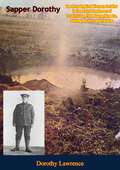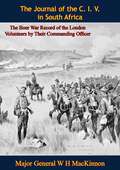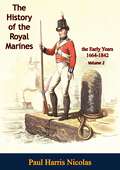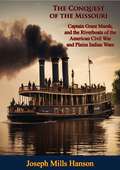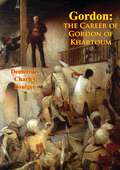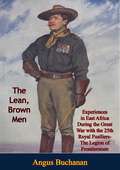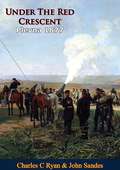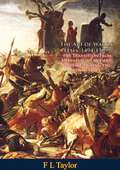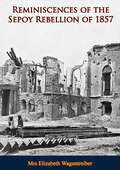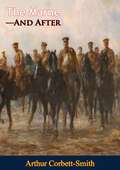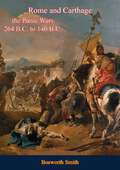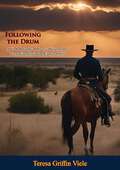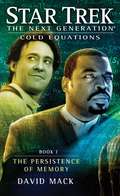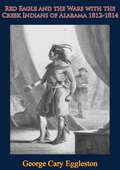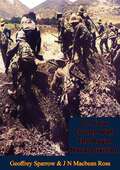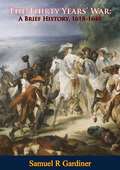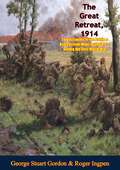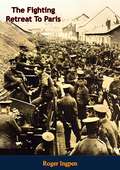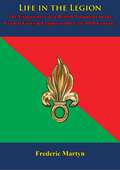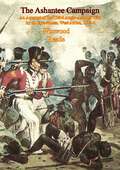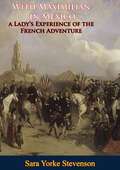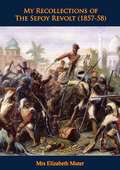- Table View
- List View
Sapper Dorothy: 51st Division, 79th Tunnelling Co. During the First World War
by Dorothy LawrenceThe adventures of an intrepid young woman on the Western FrontIt would not be quite accurate to portray Dorothy Lawrence as a bona fide soldier of the British Army. Dorothy was in fact a young woman with great aspirations to embark upon a career in journalism and she knew it would be a coup to give a female perspective of the activities of men on the front line-as it were-from within their own ranks. So she devised a scheme to bring her objectives about and its success was marked by a 10 day stint in the line at Albert in 1915 with the Royal Engineers during the opening stages of the battle of Loos. Dorothy certainly saw action—the trench she occupied lay less than 400 yards from the German front line. She was eventually discovered and the entire story of how she pulled off her subterfuge, her time in the trenches and what befell her thereafter is told in this delightful account.-Print ed.
The Journal of the C. I. V. in South Africa: The Boer War Record of the London Volunteers by Their Commanding Officer
by Major General W H MacKinnon“London men at war against the BoersThe turn of the 19th century to 20th was a time of popularity for the military volunteer movement in the British Empire. When the Anglo-Boer War broke out the City Imperial Volunteers quickly filled its ranks with the men of the City of London anxious to serve their country in South Africa. The venture was supported by the Lord Mayor and the popularity of London's effort had widespread appeal. All manner of men hurried to join the C. I. V's ranks and many of them were professionals from the city's law firms and financial institutions, artists, writers or gentlemen of private means. The author of The Riddle of the Sands, Erskine Childers was one of their number. This book is comprised of the journal entries of the officer commanding the regiment and it follows the C. I. V's wartime experiences from recruitment to its return home. The C. I. V was well regarded on campaign and earned the praise of peers and senior officers alike. This book delivers its information in the sober manner one might expect of its author in the circumstances, but is nevertheless essential source material about each part of the unit-the infantry, mounted infantry, cyclists, medical staff etc. Included as an appendix is a substantial honour role that will be of special interest to genealogists.”-Print ed.
The History of the Royal Marines: The Early Years 1664-1842: Volume 2 (The History of the Royal Marines: the Early Years 1664-1842 #2)
by Paul Harris Nicolas“The first volume of a two volume anniversary history of the early Royal Marines.The Royal Marines can trace their origins back to the formation of 'The Duke of York and Albany's Maritime Regiment of Foot' in 1664…The Royal Marines as we know them today were formed in 1755 and since that time they have distinguished themselves in many conflicts fought by the British to the present day. Numerous books have been written about the exploits of the Royal Marines, particularly in the 20th century, but this special two volume edition concentrates on the earliest period of their history. The presence of red-coated marines was inseparable from the blue uniform of their naval comrades during the great age of sail and this book covers that period in detail including the American War of Independence. The great contest of the early 19th century was against Revolutionary, Consulate and Napoleon Bonaparte's First Empire of the French. The Royal Marines fought in every major naval engagement of that long war, all of which are detailed in these pages together with many minor engagements, the War of 1812 and the imperial campaigns including the Chinese Opium Wars.”-Print ed.
The Conquest of the Missouri: Captain Grant Marsh, and the Riverboats of the American Civil War and Plains Indian Wars
by Joseph Mills Hanson“A great river and those who sailed it.This well known and highly regarded classic of the opening up of the American West concentrates on the great rivers of North America and the Missouri in particular. Focus is, of course, placed to the iconic paddle-steamers, their captains and crews, that plied its waters and that have become emblematic of river navigation in 19th century America. The scope of the narrative is significant. Events are described from the mid-1850s and through the American Civil War. However, the book principally deals with the post Civil war period of westward expansion and the role of the vessels and the river itself in the wars against the plains Indians. The transportation of troops and materials played a significant part in these campaigns and this is, of course, is recounted here in some detail. Readers will learn about the exploits of boats including the 'Far West, ' 'Key West, ' Rosebud, ' 'Luella' and 'North Alabama' in this fascinating account of the American frontier afloat.”-Print ed.
Gordon: the Career of Gordon of Khartoum
by Demetrius Charles Boulger“A great British soldierThis is the biography of one of the most famous soldiers of the Victorian age—Major-General Charles Gordon. Certainly he is now known as Gordon of Khartoum, but highly regarded in his own lifetime, he was to many also Chinese Gordon and Gordon Pasha. Commissioned as a Royal Engineer, Gordon first saw action during the Crimean War taking part in the siege of Sebastopol, the assault on the Redan and the expedition to Kinburn. In 1860 the Second Opium War broke out in China and it was here and during the Taiping Rebellion that Gordon earned his reputation and the recognition that set him towards high military rank. But it was Africa where he achieved his greatest fame. Gordon was engaged in much vital and interesting service before he found himself behind the walls of Khartoum in an unequal struggle against the religious fervour of the Mahdist forces. This is a thorough account of the man and his times which will be of great interest to those who wish to learn more about Gordon than just his martyrdom in the Sudan.”-Print ed.
The Lean, Brown Men: with the 25th Royal Fusiliers-The Legion of Frontiersmen
by Angus Buchanan“Lean men, brown men, men from overseas,Men from all the outer world; shy and ill at easeThere were Canadian Mounties, American cowboys, Arctic explorers, adventurers, rogues, big game hunters and sportsmen. There were famous men like Cherry Kearton, the naturalist and explorer and the grand old man of Africa—Frederick Selous himself. All these men had come together under the Union Flag to do battle against colonial Imperial Germany in East Africa. They came under the command of Driscoll of Driscoll's Scouts who performed with renown during the Boer War. These were the men of the 25th Royal Fusiliers—The Legion of Frontiersmen—and their battlegrounds were to be the great plains of Africa rich in wildlife and elemental danger. This is their story through the years of the Great War told by one of their own officers in vivid detail. It is a story of campaigns and hardship which would be equal to the best of them and lay many a 'lean, brown man' in a shallow grave in the red earth before it was concluded.”-Print ed.
Under The Red Crescent – Plevna 1877
by Charles C Ryan John SandesIn "Under The Red Crescent, Plevna 1877," readers are transported to the heart of one of the most pivotal moments in European history. Set against the backdrop of the Russo-Turkish War of 1877-1878, this gripping narrative chronicles the epic struggle for the Bulgarian town of Plevna.As the Russian Empire seeks to expand its influence in the Balkans and challenge Ottoman dominance, the small garrison town of Plevna becomes the focal point of a fierce and relentless battle. Led by the indomitable Ottoman commander, Osman Pasha, the defenders of Plevna are faced with overwhelming odds as they confront the might of the Russian army.Against the backdrop of political intrigue, military strategy, and personal drama, the fate of Plevna hangs in the balance. Will Osman Pasha and his valiant defenders withstand the onslaught of the Russian forces, or will the town fall, signaling a turning point in the course of history?"Under The Red Crescent, Plevna 1877" is not just a tale of warfare, but a testament to the human spirit in the face of adversity. It is a story of courage, honor, and the enduring struggle for freedom and independence. This book is essential reading for anyone interested in military history, the Balkans, or the complex dynamics of 19th-century Europe.
Bamie: Theodore Roosevelt's Remarkable Sister
by Lilian RixeyTheodore Roosevelt’s daughter Alice Roosevelt Longworth once remarked that if her “Auntie Bye” had been a man, she would have been the president.Anna Roosevelt Cowles was Theodore Roosevelt’s older sister by almost four years. She was nicknamed Bamie as a child. Her siblings, nieces, and nephews later called her “Auntie Bye” because she was always on the go.After overcoming a childhood disability, Bamie grew into a tower of strength for her immediate family and supported them throughout her life, especially after her father passed away. She also assisted her extended family at every opportunity.Throughout his life, Bamie was Theodore’s close confidante and political advisor, as well as a guiding force to other family members and friends. She was the only family member to encourage Theodore to enter politics. She planned her brother's political campaigns with Cabot Lodge and other Washington luminaries.She used her charm, perceptive judgment, and extensive contacts on both sides of the Atlantic to promote TR and his policies while and after she served as an unofficial ambassador to England.In Washington, Anna hosted regular luncheons and parties to help Theodore meet people and discuss issues with them. In fact, while he was president, Theodore was so often at his sister’s DC home that it was referred to as “the other White House”. He wrote her weekly letters, explaining he needed her help in clarifying his thoughts.Anna was a history-maker in her own right, helping to establish the US Army’s corps of nurses.Author Lillian Rixey was the grand-niece of TR’s White House physician and a journalist who was given access to unpublished material including a memoir that Bamie wrote for her son.This sparkling biography overflows with personal writings from the close-knit Roosevelt family and quotes from journalists and significant historical figures.
The Art of War in Italy, 1494-1529: the Transition From Mediaeval to Modern Warfare During the Renaissance
by F L Taylor“The birth of 'New War' in ItalyIt is easy to consider the Renaissance as a time of enlightenment typified principally by the artistic and scientific genius of Leonardo da Vinci and his peers; but giant leaps forward are never confined to one aspect of society and the application of new ideas is always adapted to various purposes and the meeting of differing objectives. The creation of modern political science by Niccolo Machiavelli is a prime example of how new ways of thinking and doing impacted on the advancement and securing of power. These changes were inevitably accompanied by significant developments in making war more effectively, strategically and tactically-with corresponding advances in weaponry and other equipage. This excellent book considers these developments through the changes to traditional military strategy and the use of infantry, cavalry and artillery, in both open battle and fortification and siege-craft, at the turn of the sixteenth century.”-Print ed.
The Herb Book: The Most Complete Catalog of Herbs Ever Published
by John Lust"I have an old copy of this book that I've had for years and would never let go of, no matter how many times I moved and thinned out my books. This is a re-release and I'm really happy to see it back in print. Part two of the book is the real treasure. It is an alphabetical list of herbs that gives detailed information about their properties, including any cautions required." — Lora's Rants & ReviewsAlso known as "The Natural Remedy Bible," The Herb Book provides a comprehensive resource for building a livelier, healthier, happier life. More than 2,000 listings offer remedies for ragged nerves, nightmares, and coughing fits as well as suggestions for adding spice to recipes, coloring fabrics, freshening breath, and a host of other benefits. Complete and concise descriptions of herbs, illustrated by more than 275 line drawings, offer the most comprehensive catalog of "miracle plants" ever published. Written by an expert and pioneer in the field, this easy-to-use reference features three parts. The first presents introductory historical information and background for using the rest of the book. The second part features individual numbered listings of medicinal plants with their botanical descriptions and uses. The third part emphasizes the variety of uses for the plants listed in Part 2, including mixtures for medicinal treatments, nutritious and culinary plants, cosmetic and aromatic purposes, plant dyes, and other applications. The book concludes with a captivating look at plant-related astrology, lore, and legends.
Reminiscences of the Sepoy Rebellion of 1857
by Mrs Elizabeth Wagentreiber“Elizabeth Wagentreiber was the youngest daughter of Colonel James Skinner of the famous cavalry regiment 'Skinner's Horse'. She had originally married a Captain Radclyffe Haldane, an officer of Skinner's Horse who was killed at the Battle of Chillianwallah during the Second Anglo-Sikh War. She subsequently married George Wagentreiber. And in the Spring of 1857 the couple were living in the civilian lines at Delhi when the Indian Mutiny broke out in the Bengal Army and reports arrived that the native cavalry was running amok in the city, slaughtering Europeans. Fearful for their lives the couple escaped with their children and the harrowing account of their time as fugitives makes compelling reading.”-Print ed.
The Marne—And After: A Companion Volume To The Retreat From Mons (classic Reprint)
by Arthur Corbett-SmithIncludes The First World War On The Western Front 1914-1915 Illustrations Pack with 101 maps, plans, and photos.“An outstanding first hand account and history of the first battles of the Great War The Great War had long been planned by Imperial Germany and its army stood ready to advance through Belgium and France with a force of overwhelming superiority. Both the Belgian and French nations rushed to arms, but were overwhelmed. The small British regular army in the form of the B. E. F was mobilised and thrown into the battle line in a matter of days. It met the advancing German masses at Mons and, much to the astonishment of the enemy, who allegedly referred to the B. E. F as that 'contemptible little army, ' gave a superb account of itself. However, no army of its size could hold against the numbers that opposed it and it was inevitable that it would be overrun. So began one of the most outstanding achievements in the history of the British Army, the dogged retreat from Mons. The man of the hour was undoubtedly Smith-Dorrien, commander of II Corps, who, when it was clear that retreat was no longer possible, saved the army from annihilation when he ordered his men to stand and fight around Le Cateau. The allies halted before Paris, turned and began a counter offensive across the Marne and Aisne that rolled the German invaders back to Ypres. Arthur Corbett-Smith was an officer of the Royal Horse Artillery and was present throughout the events described here. His first-hand experiences, anecdotes and history of the campaign are a highly readable narrative which delivers the facts of the events of Summer and Autumn, 1914.”-Print ed.
Rome and Carthage: The Punic Wars 264 B. C. To 146 B. C.
by Bosworth Smith“The battles for control of the lands of Middle SeaThis book usefully, concisely and comprehensively describes the history of the conflict that raged for a century between the Roman Republic and the Carthaginian Empire. In the ancient world these were among the largest conflicts ever fought. At the outset of this struggle the Carthaginians, who had come from Phoenician beginnings, were the dominant power in the Mediterranean region. Rome was aggressively in the ascendant grasping territory with ruthless efficiency. Each side realised that there was only room for one power of imperial influence in the region and that this was a war without compromise—victory or annihilation. The famous and infamous commanders of both forces appear within these pages, including the indomitable Hannibal Barca and Scipio Africanus, together with the equally renowned battles and campaigns that they fought from Spain to Italy and upon the sands of North Africa itself. The contest resulted, of course, in the destruction of Carthage as Rome rose to be the most significant imperial power of the ancient world. Contains useful battle field maps.”-Print ed.
Following the Drum: A U. S. Infantry Officer's Wife on the Texas Frontier in the Early 1850's
by Teresa Griffin Viele“A view of the early Texan frontier from a female view pointTeresa Viele was a strong minded woman with clear cut views. Fate would dictate that her life would not be defined by her experiences as an army wife, but in this book she has left us a significant insight into the activities of the officers, soldiers and families of a United States Infantry regiment on the Texas frontier in the pre-Civil War period. Her account encompasses everything that came under her eye and into her active mind-from travel, landscape, flora, fauna and food. Less domestically, she turned her thoughts and pen to the subject of Mexicans and United States political relations with Mexico, the omnipresent threat of Comanche raiders and the ability and capacity of the army to fulfil its border protection duties. Viele also provides an interesting perspective on Jose Maria Jesus Carbajal and the Merchants War. This is an unusual female viewpoint on life on the early South Western American frontier and is an important chronicle of a woman in Texas during the pioneer period.”-Print ed.
My Cousin Maria Schneider: A Memoir
by Vanessa Schneider&“A beautiful eulogy and a much-needed corrective&” (The New York Times)—a love letter to Maria Schneider, the 1970s movie starlet who catapulted to fame in the controversial film Last Tango in Paris—only to live the rest of her life plagued by scandal, as told from the perspective of her adoring younger cousin.The late French actress Maria Schneider is perhaps best known for playing Jeanne in the provocative film Last Tango in Paris, directed by Bernardo Bertolucci and released to international shock and acclaim in 1972. It was Maria&’s first major role, alongside film legend Marlon Brando, when she was barely eighteen years old. The experience would haunt her for the rest of her life, traumatizing her and sparking a tabloid firestorm that only ceased when she began to retreat from the public eye nearly two decades later. To Maria&’s much younger cousin, Vanessa Schneider, Maria was a towering figure of another kind—a beautiful and fearsome fixture in Vanessa&’s childhood, a rising star turned pariah whose career and struggles with addiction won the family shame and pride in equal measure. Here, Vanessa recounts the challenges of their overlapping youths and fraught adulthood and reveals both the tragedy and inevitability of Maria&’s path in a family plagued by mental illness and in a society rife with misogyny. Unsentimental and moving, My Cousin Maria Schneider is a love letter to a talented artist and the cousin who admired her, and a powerful story of exploitation and how its lingering effects can reverberate through a lifetime.
Cold Equations: Book One (Star Trek: The Next Generation)
by David MackBook One in the New York Times bestselling trilogy set in the expanded universe of Star Trek: The Next Generation!A BRAZEN HEIST Captain Jean-Luc Picard and the Enterprise crew race to find out who has stolen Data’s android brother B-4—and for what sinister purpose. A BROKEN PROMISE One desperate father risks all for the son he abandoned forty years ago—but is he ready to pay the price for redemption? A DARING MISSION Against overwhelming odds, and with time running out, Commander Worf has only one chance to avert a disaster. But how high a price will he pay for victory?
Red Eagle and the Wars with the Creek Indians of Alabama 1812-1814
by George Cary Eggleston“Red Sticks, White Sticks and the war in AlabamaThe Creek Indian War, also known as the Red Stick War, took place between 1813-1814 and has been considered by many historians as part of the War of 1812. The Creek—or Muscogee—Indians of Alabama were effectively waging a civil war among themselves. One militant faction, the so called Red Sticks, proposed an aggressive return to the traditional life of their forebears and an end to treaties with and concessions to pioneer settlers represented by the United States government. The White Sticks, opting for peace, inevitably took the opposing view. Although the conflict began as one between the indigenous Indians, American forces, under the soon to be famous Andrew Jackson among others, were drawn into the conflict because much of the animosity was focussed on pioneer settlements. The conflict started in the usual manner of American Indian Wars—with the murder of settler families. The inevitable revenge and retribution that followed—and an escalation of the kind of merciless savagery the Americans had come to expect—culminated in the massacre of 500 settlers, friendly Indians, mixed blood Creeks and soldiers at Fort Mims in an attack led by the Red Stick war leader, Red Eagle. Other forts were also attacked. Panic spread through the region exacerbated by the inability of the Federal government to provide ready aid since it was engaged against the British and their Indian allies to the east. As a consequence much of the fighting was undertaken by militias from Tennessee, Georgia and Mississippi supported by White Stick allies. National hero, Davy Crockett, also served in this conflict. The war ended in a victory for the Americans and put Andrew Jackson on a path to the presidency and the White House. It was a disaster for the entire Creek Indian tribe—irrespective of their allegiances—who paid for the conflict through the confiscation of vast tracts of their traditional lands.”-Print ed.
On Four Fronts with the Royal Naval Division
by Geoffrey Sparrow J N Macbean Ross“The Blue Jackets who fought on landThe time of Nelson was not only notable because of the success in nautical warfare of the man himself, but also because it was the zenith of the 'age of sail' that left British sea power so dominant that Britannia really did 'rule the waves.' No navy could stand against the might of the Royal Navy, and so until Jutland during the Great War it would not fight another major battle at sea. Queen Victoria's ever expanding empire meant that British forces were perpetually set against often underdeveloped powers and the navy took its part, but most of the hard work of empire building would inevitably fall upon the British army. Of course, the Royal Navy had its own 'soldiers'—the Royal Marines. The particular talents and skills of sailors were often required, particularly whilst manning 'the guns, ' so the 19th century saw the 'blue jackets' in action in the Crimean War, the Indian Mutiny, the Zulu War, the Boer War and several other conflicts. The early years of the 20th century brought a period of instability that inexorably dragged the great powers of Europe towards the cataclysm of blood which was to be the Great War of 1914-18...The Royal Naval Division was formed around a cadre of Royal Marines and sailors and was expanded as a unit of the New Army by volunteers. The Division saw action in the defence of Antwerp in 1914, on Helles and Anzac during the disastrous Gallipoli Campaign in 1915 and on the Western Front where it took part in the Battle of the Somme in 1916 and the Third Battle of Ypres in 1917. This book was written by one of the their number and is an often light-hearted account of the wartime record of the division, full of incident and anecdote and scattered with occasionally humorous line drawings. There is little in print about the Royal Naval Division in the First World War so this will make a welcome addition to any naval library.”-Print ed.
The Thirty Years' War: A Brief History, 1618-1648
by Samuel R Gardiner“A concise history of a cataclysmic European conflict in the 17th centuryThe Thirty Years' War was fought between 1618-1648 and is widely recognised as being one of the most destructive wars ever fought. More people lost their lives in this conflict, as a percentage of the total population at the time, than in the conflicts of the twentieth century. Fought principally in central Europe—and mostly over terrain now in modern day Germany—the war involved more than fifteen nation states. Forces were divided broadly on religious grounds, between Protestants and their allies and the Catholics of the Holy Roman Empire and Spain but also with elements of the Ottoman Turkish Empire. Self evidently this was a long, bloody conflict the causes of which were many and complex. Dynasties were born in its tumult, great men were brought to the fore and some, like Gustavus Adolphus of Sweden, would perish before its conclusion. The campaigns and battles of the Thirty Years' War have inspired historians across the centuries to the present day to write about them and many highly regarded works concerning the war have been published. This concise book takes a different approach; it sets out to give an understanding of the events and personalities involved and is an ideal overview for both specialists and those new to the subject.” – Print ed.
The Great Retreat, 1914: During the First World War [Illustrated Edition]
by George Stuart Gordon Roger IngpenIncludes The First World War On The Western Front 1914-1915 Illustrations Pack with 101 maps, plans, and photos.“Two views of the Great RetreatImperial Germany had long planned the conflict that was to become the First World War, but when the onslaught came there was little sign that the nations which would be embroiled were prepared for the storm. Germany advanced in the east and west where French and Belgian armies were forced to retire by overwhelming odds. The small British Army, the 'B. E. F', was rushed to the continent with most of its troops having less than a week between garrison life and the firing line. Under Sir John French, it was allocated the western end of the line, and at Mons it inflicted far more causalities on the enemy than its numbers would suggest. No army of its size, however, could stand against the German superiority in men (at least five to one) or artillery and machine guns. An envelopment was inevitable and so a stubbornly fought retreat was ordered. Near Le Cateau, the British turned at bay and Smith-Dorrien's determination to stand and fight undoubtedly saved the British Army from annihilation. Many people imagine the First World War as a stalemate of mud, wire and trenches, but in the first six months it was a great European war fought in much the same way that Napoleon, Wellington and Blucher had fought a century before.”-Print ed.
The Fighting Retreat To Paris
by Roger IngpenIncludes The First World War On The Western Front 1914-1915 Illustrations Pack with 101 maps, plans, and photos.A fascinating view of the opening phases of the First World War.“Imperial Germany had long planned the conflict that was to become the First World War, but when the onslaught came there was little sign that the nations which would be embroiled were prepared for the storm. Germany advanced in the east and west where French and Belgian armies were forced to retire by overwhelming odds. The small British Army, the 'B. E. F', was rushed to the continent with most of its troops having less than a week between garrison life and the firing line. Under Sir John French, it was allocated the western end of the line, and at Mons it inflicted far more causalities on the enemy than its numbers would suggest. No army of its size, however, could stand against the German superiority in men (at least five to one) or artillery and machine guns. An envelopment was inevitable and so a stubbornly fought retreat was ordered. Near Le Cateau, the British turned at bay and Smith-Dorrien's determination to stand and fight undoubtedly saved the British Army from annihilation. Many people imagine the First World War as a stalemate of mud, wire and trenches, but in the first six months it was a great European war fought in much the same way that Napoleon, Wellington and Blucher had fought a century before.”-Print ed.
Life in the Legion: The Experiences of a British Volunteer in the French Foreign Legion in the Late 19th Century
by Frederic MartynOn campaign under the tricolor“This is an essential book for all those interested in the French Foreign Legion because it is a brilliant first hand account written by an English 'gentleman volunteer' who experienced 'life in the legion' in the late 1880's and who had previously been a serving officer in one of the cavalry regiments of the British Army. Far from being a tale of hardship and abuse, the author had nothing but admiration for the Legion and—as an experienced soldier—obviously thoroughly enjoyed the five years he spent serving in its ranks. The writer quite simply could not have enough action and he volunteered to serve in Tonkin, Dahomey and against the Tuareg tribesmen of North Africa. In consequence this book is full of colourful and detailed campaign and battle action which is compellingly recounted by a fighting soldier more than capable of putting his engrossing story into words. Highly recommended.”-Print ed.
The Ashantee Campaign: An Account of the Third Anglo-Ashanti War by an Eyewitness, West Africa, 1873-4
by Winwood Reade“Colonial warfare on the Dark ContinentThe British Empire rapidly spread its influence throughout the globe during the nineteenth century. Predictably these intrusions rarely found favour with the indigenous populations and so, inevitably, the imperial interests of power and commerce were reinforced by the imposition of military and naval might courtesy of the British Army and the Royal Navy. British interests in West Africa proved to be no exception to the rule and the so called 'Ashanti Wars' were fought with varying degrees of savagery and through eight campaigns from 1806 until 1900. This book is about the Third Anglo-Ashanti War which was fought during 1873-74. Garnet Wolseley, commanding a force of British, West Indian and local forces marched against the Ashanti who had invaded British territory. The campaign gained particular notoriety because it occurred during the golden age of newspaper correspondents and was covered by both G. A. Henty and Henry Morton Stanley. It made Wolseley's reputation and he became a household name. The conflict was made singular by the nature of the terrain-often thick jungle-across which it was fought and by its exotic protagonists and this makes it a subject of particular interest for students of the colonial wars in the Victorian era. The outcome of the war was, perhaps, predictable and the British both occupied the enemy capital Kumasi and then burnt it down as an object lesson. This book is particularly useful because the author was an eyewitness to the storming of Amoaful by the Black Watch, the storming of Ordahsu by the Rifle Brigade and the fall of the capital.”-Print ed.
With Maximilian in Mexico: a Lady's Experience of the French Adventure
by Sara Yorke Stevenson“A remarkable experience of little reported events.The Second Empire of France was, by the early 1860's in good health. France had acquitted itself well in the Crimea and in the war against Austria. The idea of a European monarch on the throne of Mexico was not a new one. France was attracted to the idea of a 'Latin' influence in America and thus the opening chords were struck of what would eventually be—to quote the author—'A Dance of Doom', the steps of which would lead the Archduke Maximilian to a stark wall there to be riddled with bullets from a Mexican firing squad. The author of this account—a young American woman living in Paris—was swept up in these extraordinary events and found herself in Mexico amongst its most influential figures. This is her essential and riveting story of turmoil and rebellion.”- Print ed.
My Recollections of The Sepoy Revolt (1857-58)
by Mrs Elizabeth Muter“Mrs Elizabeth McMullin Muter was married to a captain of the 1st Battalion 60th King's Royal Rifles stationed in Meerut, a few hours travel east of Delhi, when the mutiny among the sepoys of the garrison broke out there on Sunday morning of May 10th, 1857. Elizabeth Muter graphically describes the horrors of those first days of the conflict from the perspective of the wives of officers who were set adrift in times of peril and uncertainty as their husbands left them to fight. This book also contains some campaign recollections by Captain Muter.”-Print ed.
